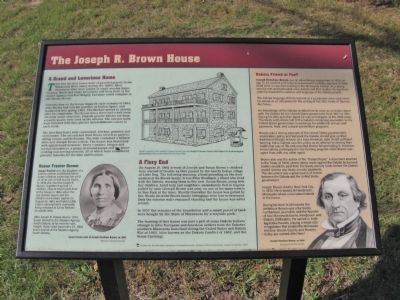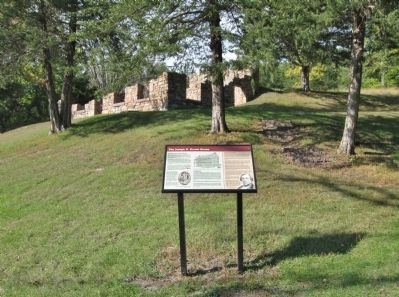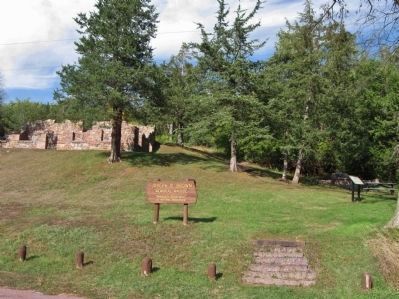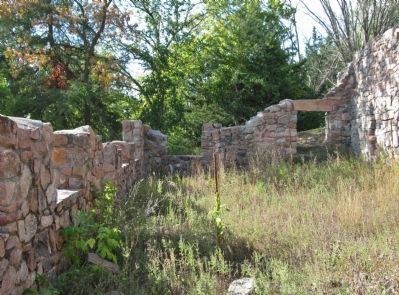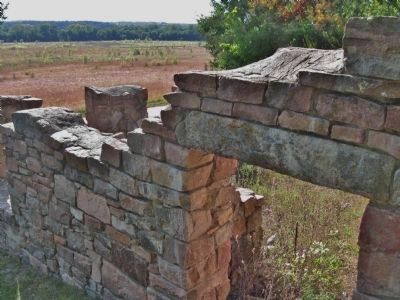Near Sacred Heart in Renville County, Minnesota — The American Midwest (Upper Plains)
The Joseph R. Brown House
A Grand and Luxurious Home
This was the first house built of quarried granite in the Minnesota River valley during the 1860s. Most structures then were cabins or small wooden frame houses. Brick and stone structures had been built at the Lower Agency and Fort Ridgely but none could compare to the Brown House.
Construction on the house began in early summer of 1861, after Brown had lost his position as Indian Agent, and finished in late-spring of 1862. The Browns moved in shortly after its completion. The house was a three-and-a-half story, 19-room stone structure. Pinkish granite blocks cut from a nearby quarry were used on the exterior. The interior walls were finished with lime plaster tinted different colors in each room.
The first floor had a wide central hall, kitchen, pantries and storerooms. The second and third floors served as parlors, sitting rooms, and bedrooms. The attic contained a billiard table and Joseph Brown’s desk. The house was furnished with upholstered furniture, heavy curtains, bronze and crystal chandeliers, a piano, kerosene lamps and the latest cooking and serving utensils, all of which were considered genuine luxuries for the time and location.
Susan Frenier Brown
Susan Frenier was the daughter of a Dakota mother and French father. Susan's Dakota name was hin ya zi ce du ta win or Soft Scarlet Down. In 1836 she married Joseph R. Brown. Together they had 11 children, most of whom were here at the house in 1862 when the war started. Susan and her children were taken captive on August 20, 1862, and held in Little Crow’s encampment, eventually being released at Camp Release six weeks later.
After Joseph R. Brown died in 1870, Susan moved to the Sisseton Agency, South Dakota, to be near her son, Joseph. Susan died December 23, 1904, and is buried at the Sisseton Agency, South Dakota.
A Fiery End
On August 18, 1862 several of Joseph and Susan Brown's children were warned of trouble as they passed by the nearby Indian village of Little Dog. The following morning, a loud pounding on the door awakened the Brown family. It was Peter Roulliard, a friend who lived with the Dakota, warning them to flee now. Susan Brown, along with her children, hired help and neighbors, immediately fled in wagons pulled by oxen (Joseph Brown was away on one of his many travels to New York at the time). Shortly thereafter the house was gutted by fire. Nearly all of the Brown family belongings were lost or destroyed. Only the exterior walls remained standing and the house was never rebuilt.
In 1937 the remains of the foundation and a small parcel of land were bought by the state of Minnesota for a wayside park.
The burning of this house was just another part of some Dakota Indians' failed attempt to drive European and American settlers from the Dakotas’ southern Minnesota homeland during the United States and Dakota War of 1862, (also known as the Dakota Conflict of 1862, and the Sioux Uprising).
Dakota Friend or Foe?
Joseph Renshaw Brown was an adventurous young man. In 1820, at age 15, he traveled with Colonel Leavenworth's military regiment, to help build what is now Fort Snelling in the Minnesota frontier. As a young man he met and befriended many Dakota and their leaders. During those years he learned the customs and language of the Dakota people.
The Dakota language skills he learned as a young man were used when he served as an interpreter for the writing of the 1851 treaty of Traverse des Sioux.
His knowledge of the Dakota enabled him to serve as an Indian Agent with the Dakota for the United States government from 1857 to 1861. During his time as Indian Agent he was an instigator of the 1858 treaty. This treaty sold almost half of the Dakota's remaining reservation to the United States government in exchange for additional annual cash payments, food, and cultural assimilation programs.
Brown was a strong advocate of the United States government's assimilation policy and believed the
Dakota should give up their traditional lifestyle in favor of a Euro-American style of self-sufficient farming. Many Dakota saw this policy as an attempt to destroy their traditional way of life and resented Brown for promoting it. However, more Dakota participated in the farming program while Brown was agent than with any other agent.
Brown also was the author of the "Traders Paper," a document attached to the Treaty of 1858, where claims made against the Dakota by licensed traders would be paid from the treaty annuity funds before the Dakota would receive any treaty annuity payments. This document was a great source of friction between the Dakota and the United States government.
Joseph brown died in New York City in 1870. He is buried at Henderson, Minnesota where a monument stands in his honor.
During his time in Minnesota the ambitious Brown was a fur trader, lumberman, journalist, and the founder of two Minnesota towns, Henderson and Dakota (Stillwater). He served in both legislative houses, playing a major role in legislation that created the Minnesota territory. Brown County and Browns Valley are named after him.
Captions:
• Artist’s concept of the Joseph R. Brown house from the Joseph R. Brown House Final Report On Archaeological Excavations, Minnesota Historical Society, 1968.
• Susan Frenier,
wife of Joseph Renshaw Brown, ca.1860 Minnesota Historical Society.
• Joseph Renshaw Brown, ca.1860 Minnesota Historical Society.
Produced by the Minnesota Department of Natural Resources, Division of Parks & Recreation, Interpretive Services, 2007
Erected 2007 by Minnesota Department of Natural Resources, Division of Parks & Recreation, Interpretive Services.
Topics and series. This historical marker is listed in these topic lists: Native Americans • Settlements & Settlers • Wars, US Indian. In addition, it is included in the Minnesota Historical Society series list. A significant historical month for this entry is December 1861.
Location. 44° 41.779′ N, 95° 19.356′ W. Marker is near Sacred Heart, Minnesota, in Renville County. Marker is on 145th Street (County Road 15) 0.1 miles west of 180th Street, on the left when traveling east. Touch for map. Marker is in this post office area: Sacred Heart MN 56285, United States of America. Touch for directions.
Other nearby markers. At least 8 other markers are within 6 miles of this marker, measured as the crow flies. Farther and Gay Castle (a few steps from this marker); The Kittelsland Water Wheel (approx. 1.4 miles away); The Enestvedt Marker (approx. 1.4 miles away); A Family's Proud Heritage (approx. 1½ miles away); A New Life with Family and Friends
(approx. 2.2 miles away); Boiling Spring (approx. 3.1 miles away); Vicksburg Cemetery (approx. 5.1 miles away); Taoyateduta Leads His People in War (approx. 5.4 miles away). Touch for a list and map of all markers in Sacred Heart.
Also see . . .
1. Joseph Brown House Ruins. Wikipedia entry. (Submitted on October 18, 2013.)
2. US-Dakota War of 1862. Minnesota Historical Society website entry (Submitted on October 18, 2013.)
Additional keywords. Farther and Gay Castle
Credits. This page was last revised on July 24, 2023. It was originally submitted on October 18, 2013, by Keith L of Wisconsin Rapids, Wisconsin. This page has been viewed 1,625 times since then and 106 times this year. Last updated on June 22, 2023, by Kimberly Jakes of Pennock, Minnesota. Photos: 1, 2, 3, 4, 5. submitted on October 18, 2013, by Keith L of Wisconsin Rapids, Wisconsin. • J. Makali Bruton was the editor who published this page.
